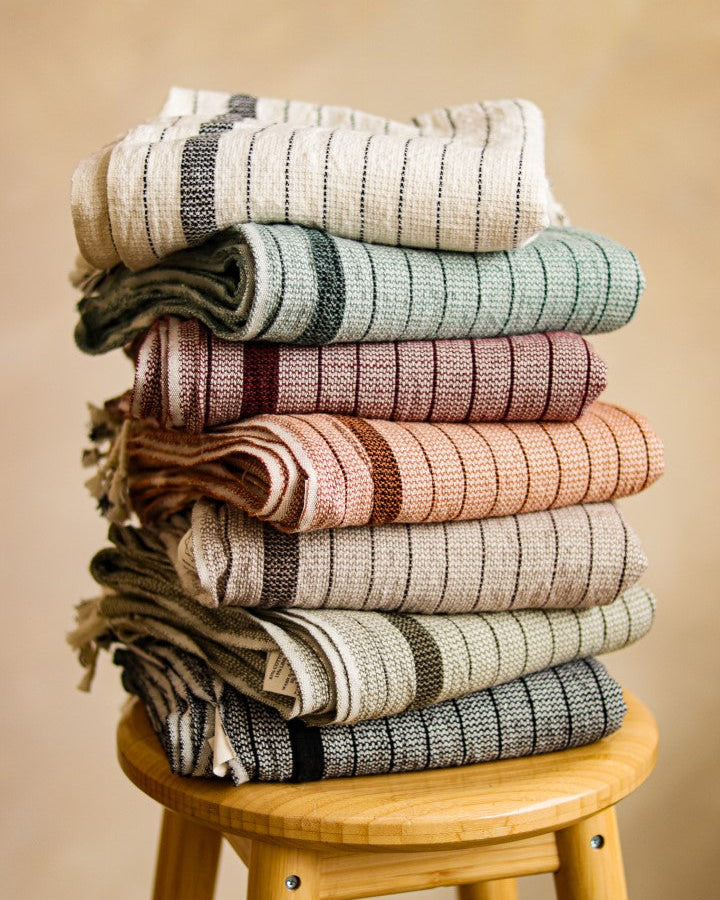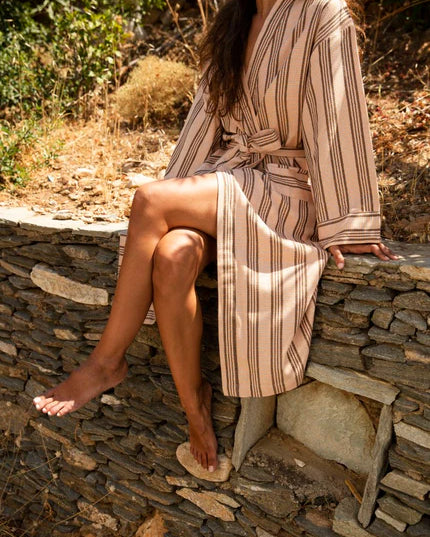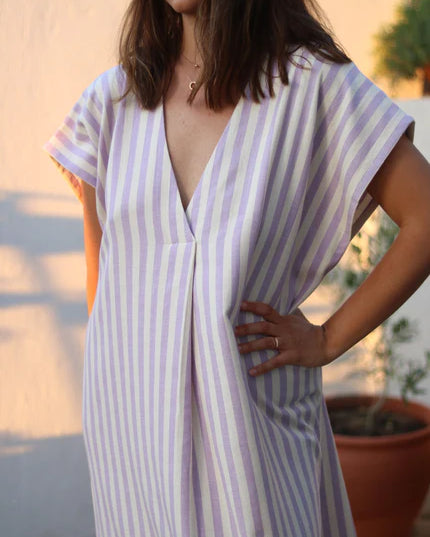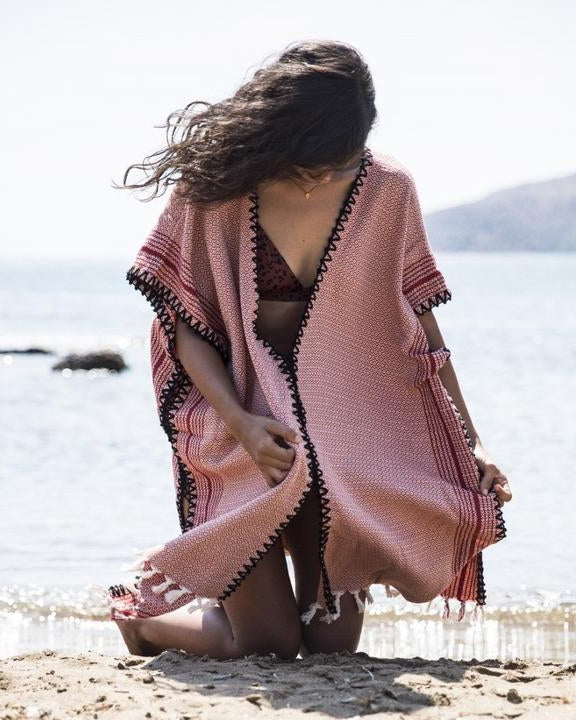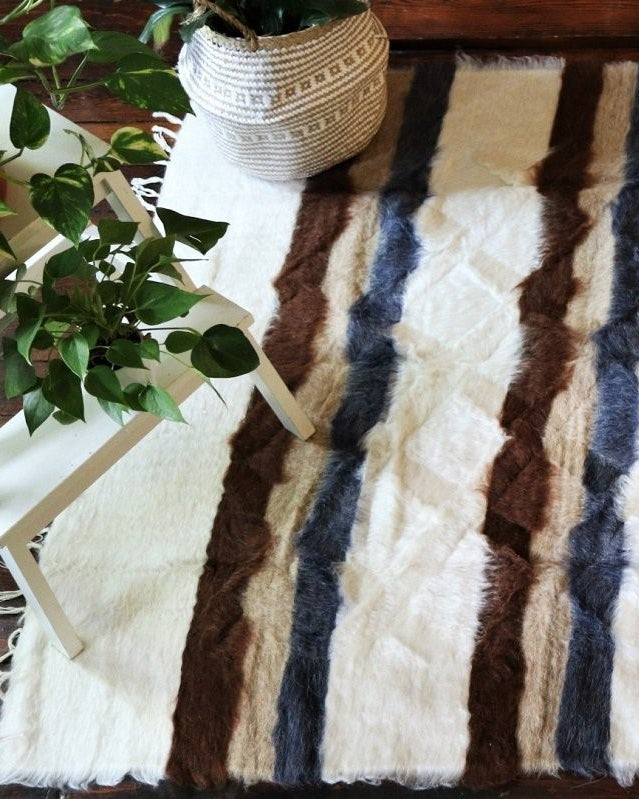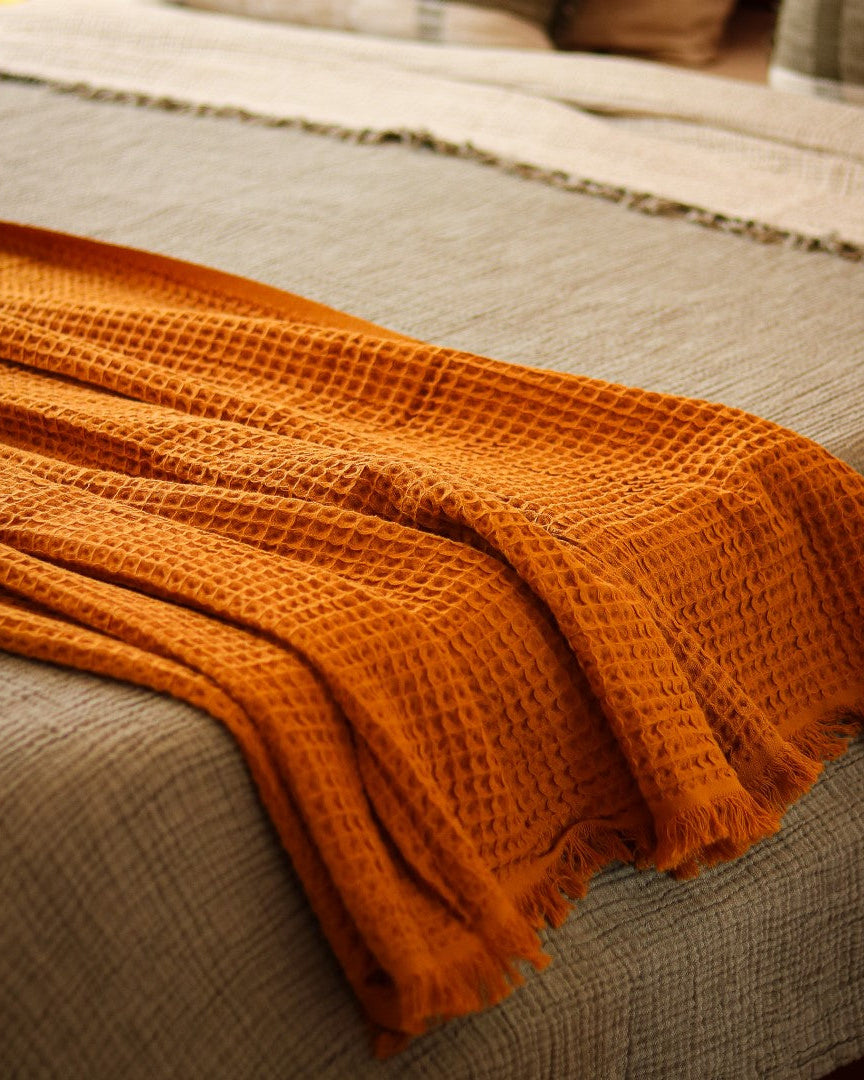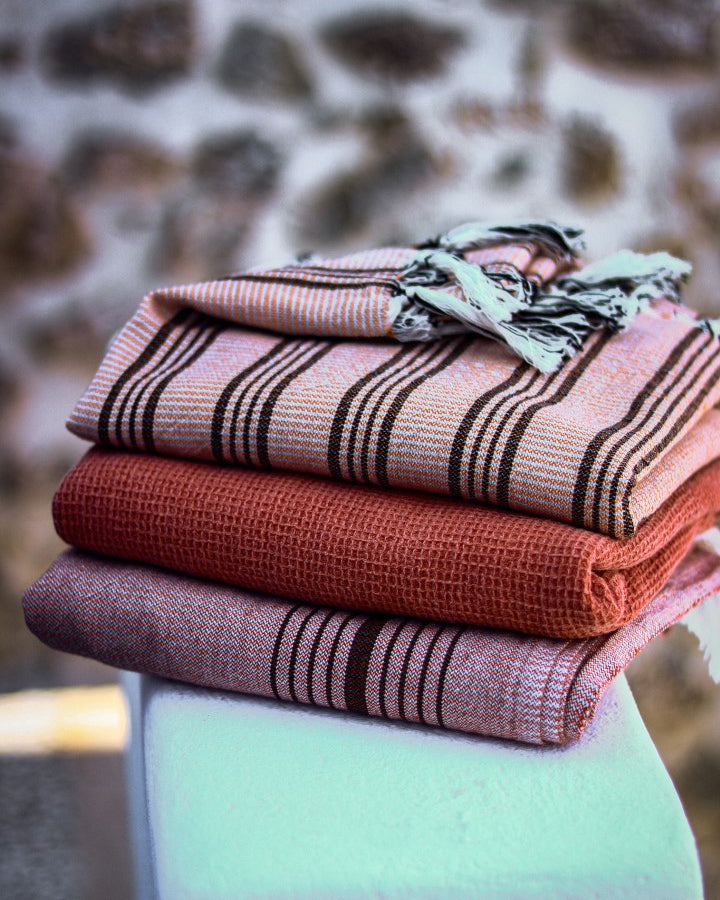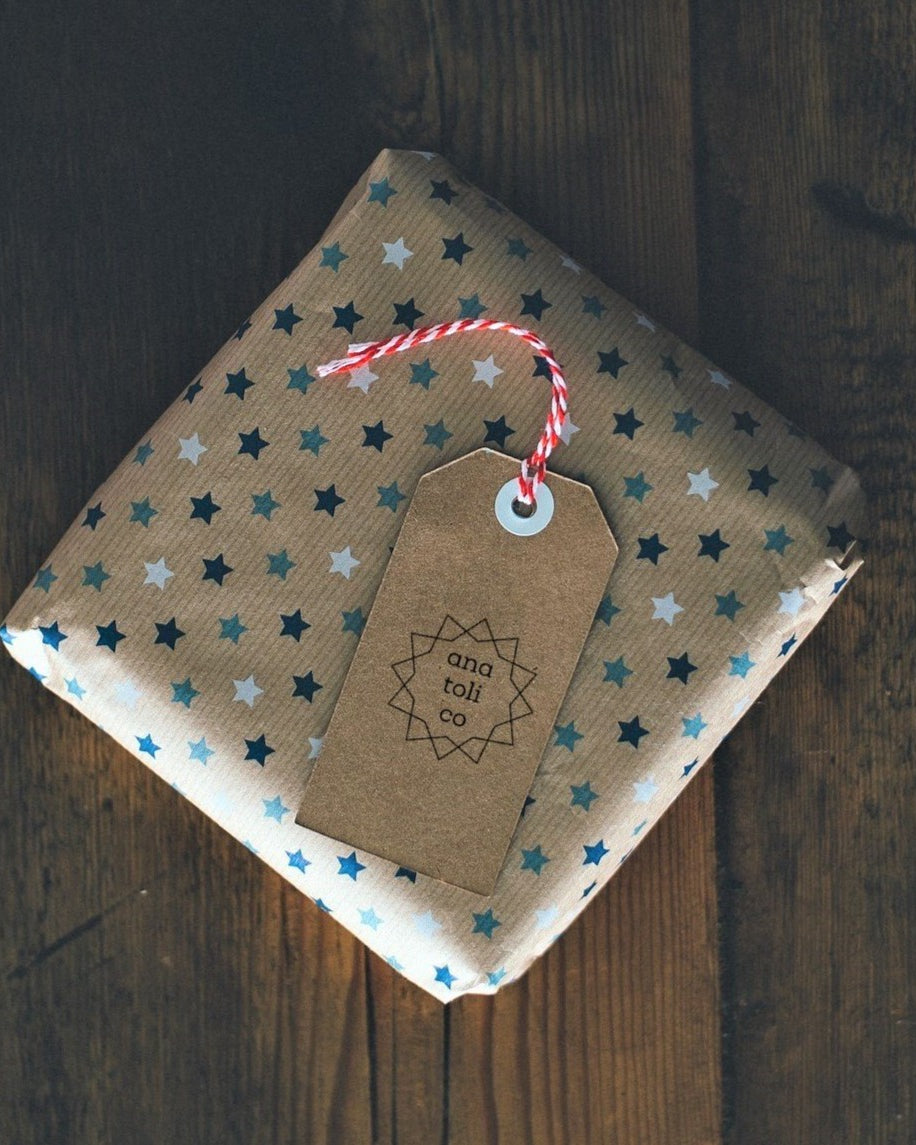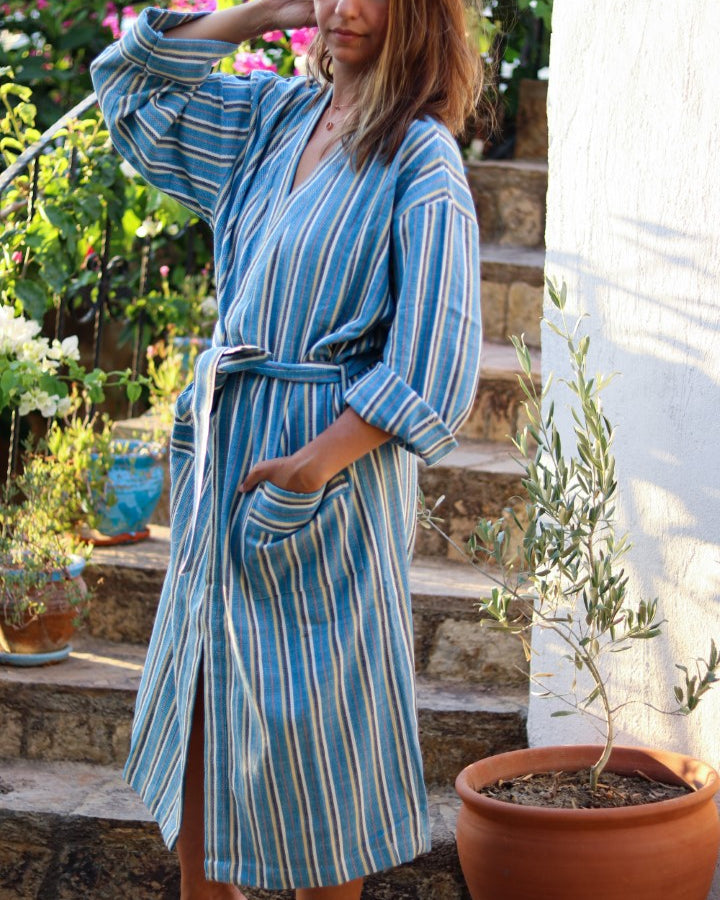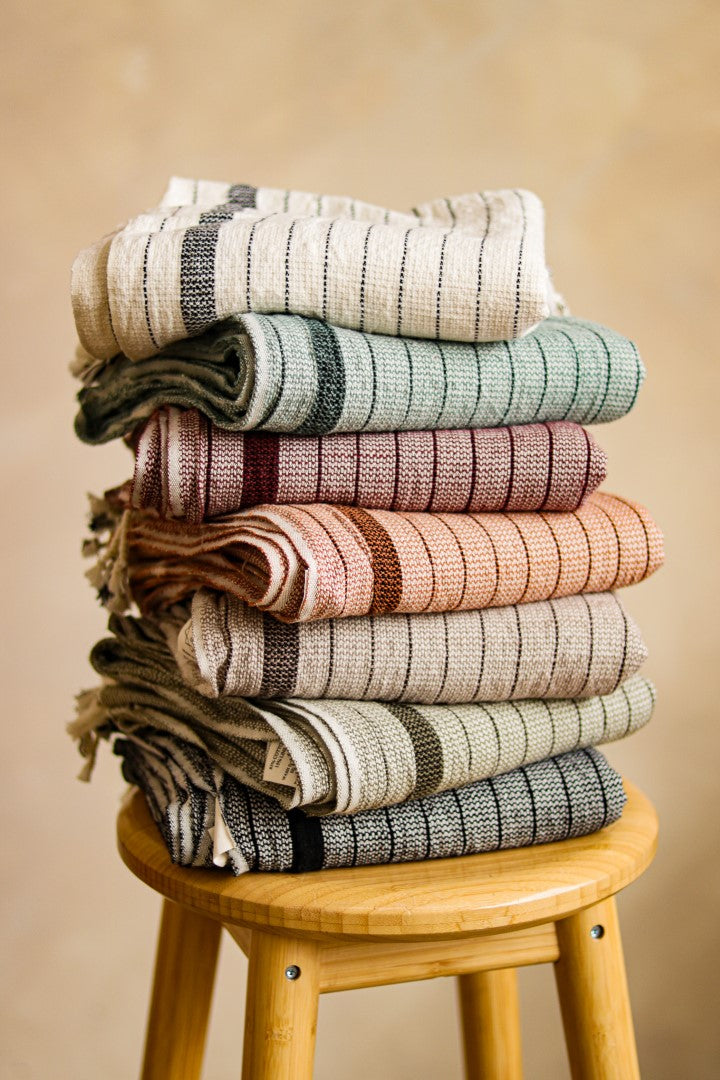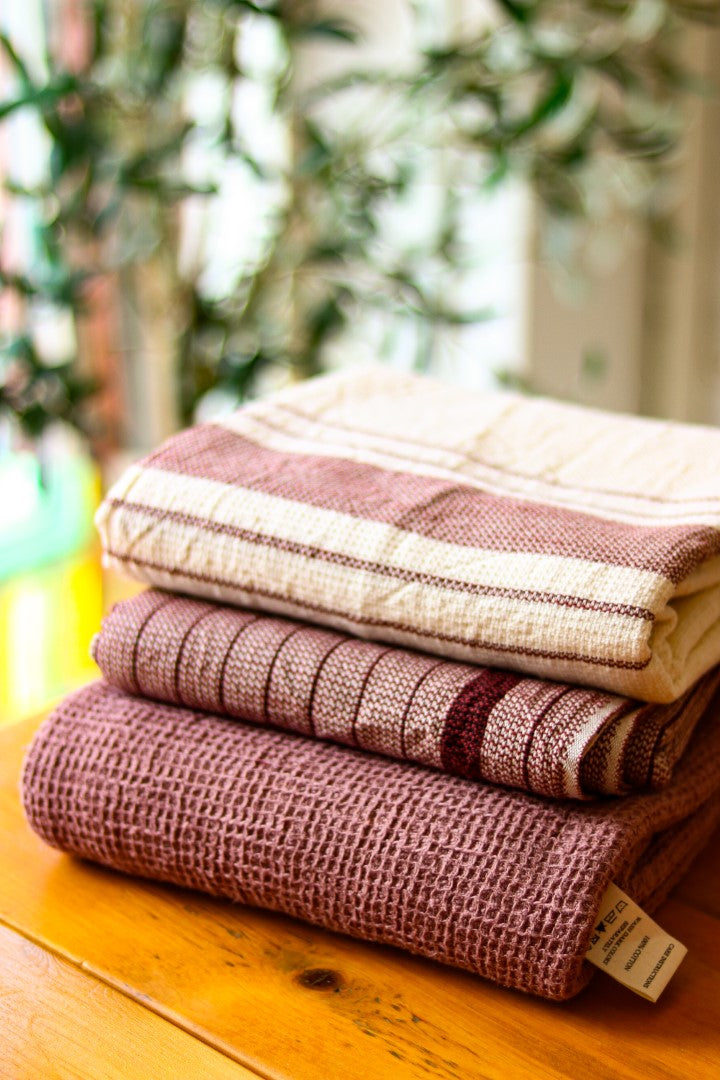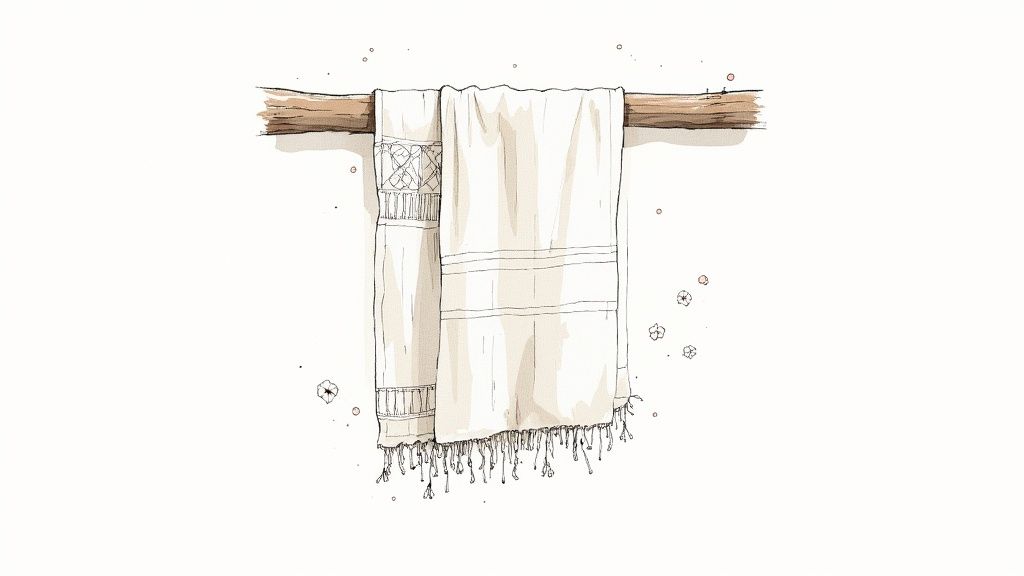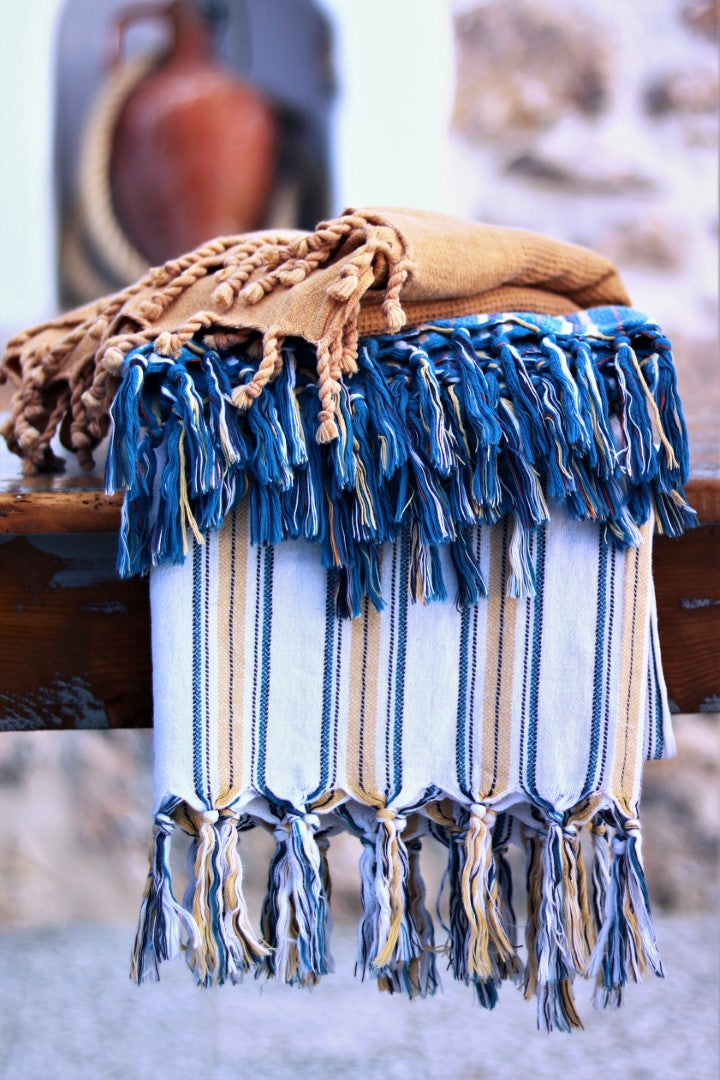When you're packing for a day by the ocean, the best Turkish beach towel is a game-changer. It's the perfect mix of a lightweight feel and serious absorbency. Forget those bulky terrycloth towels; these are woven from special long-staple Turkish cotton, which makes them incredibly quick-drying, compact, and way softer than you'd expect. This smart design is exactly why they've become the go-to for savvy travelers and beach lovers.
Why Turkish Towels Are the Ultimate Beach Companion
Ever wonder why seasoned travelers and sun-seekers are so obsessed with Turkish towels, also known as peshtemals? It’s not just a trend; it's about a clever, practical design that has been perfected over centuries. The real secret is in their unique flat-woven construction, which is a world away from the heavy, looped fabric of the towels most of us grew up with.
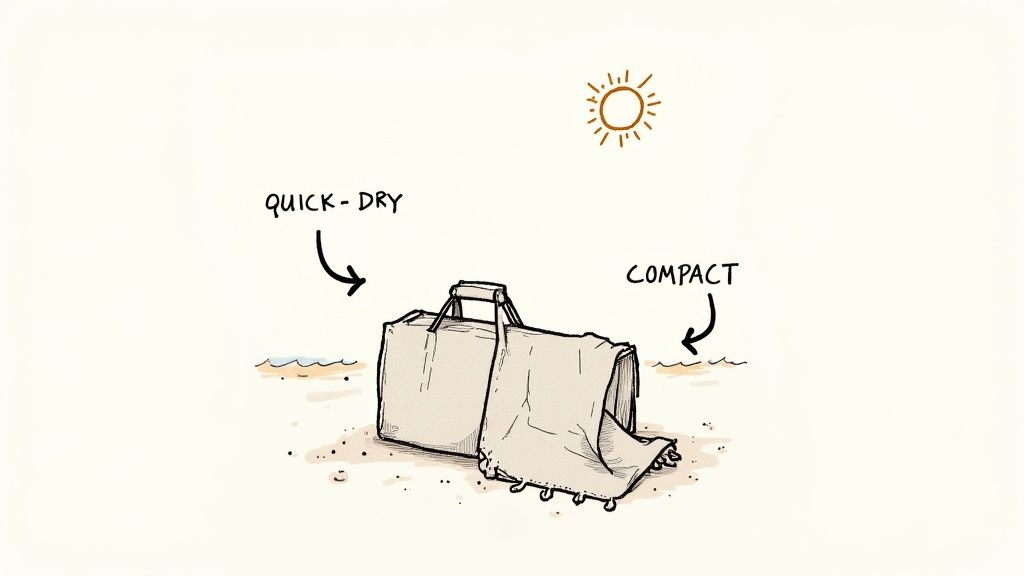
This single difference makes all the difference. Think about it: no more hauling a heavy, sopping-wet towel home from the beach. Because they're so thin and breathable, Turkish towels dry in a ridiculously short amount of time, which means they don't get that funky, musty smell. That alone makes them an essential piece of any beach kit.
To really see the difference, let's put them side-by-side.
Turkish Towel vs Traditional Terrycloth at a Glance
This quick comparison table shows just how much of an upgrade a Turkish towel can be for your beach days.
| Feature | Turkish Towel (Peshtemal) | Traditional Terrycloth Towel |
|---|---|---|
| Drying Time | Dries in a fraction of the time, often within an hour in the sun | Stays wet for hours, trapping moisture and mildew |
| Portability | Folds down to a small, compact size that saves bag space | Bulky and heavy, especially when wet |
| Absorbency | Highly absorbent due to long-staple cotton fibers | Absorbent, but becomes waterlogged and heavy quickly |
| Sand Resistance | Sand shakes right off the flat-woven surface | The looped pile traps sand, which is a pain to get out |
| Versatility | Doubles as a sarong, scarf, blanket, or wrap | Primarily just a towel; too bulky for other uses |
| Softness | Gets softer and more absorbent with every wash | Can become stiff and scratchy over time with repeated washing |
It’s clear that the peshtemal isn't just a different style—it's a fundamentally more practical and enjoyable choice for the beach.
More Than Just a Towel
Beyond just drying you off, the best Turkish beach towels are masters of multitasking. Their light, stylish design means they can effortlessly shift roles, which is a dream for anyone who likes to pack light.
Here are just a few ways they prove their worth:
- A Stylish Sarong: Tie it around your waist for a chic, easy cover-up when you head to the beach bar.
- An Impromptu Picnic Blanket: Spread it out for a clean spot on the sand that won’t trap every grain.
- A Lightweight Travel Wrap: Drape it over your shoulders as a scarf or shawl when the evening breeze picks up.
- A Protective Sunshade: Need a little break from the sun? Just hang it up for some instant shade.
This multi-use capability is what truly elevates the Turkish towel from a simple accessory to an essential travel tool. You pack one item, but you get the functionality of four.
The demand for better beach gear is definitely on the rise. The global market for beach towels is expected to grow from $4.2 billion in 2025 to a massive $7.9 billion by 2035. While Turkey isn’t the world's biggest producer, its reputation for premium cotton and authentic craftsmanship makes its towels a coveted luxury item. To dive deeper into these figures, you can read more about the growing beach towel market and see what's driving the trend.
The Story and Craftsmanship Behind Your Towel
Every real Turkish towel, or peshtemal, has a story that starts centuries ago. But it doesn't begin on a sandy beach—it starts inside the warm, steamy walls of a Turkish hammam. These traditional public baths were the heart of Ottoman social life, places for cleansing and community. A heavy, soggy towel just wasn't practical in that environment.
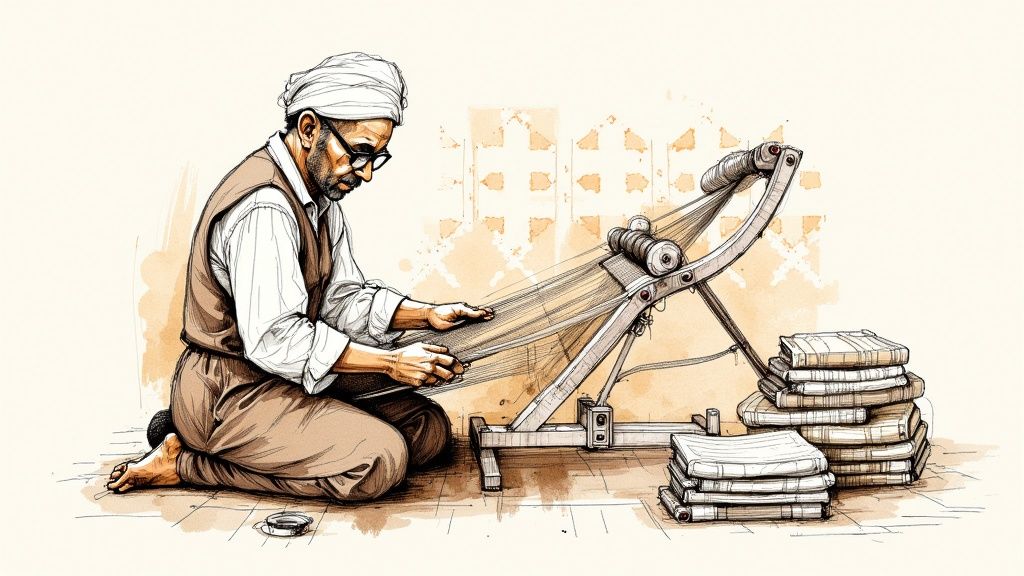
This simple, practical need led to the creation of the peshtemal. Woven from the incredible long-fiber cotton native to the region, these flat-woven towels were lightweight, incredibly absorbent, and dried in a flash, even in the humid air of the bathhouse. You could say they were the original performance fabric, perfected centuries before we ever coined the term.
From Ancient Baths to Modern Beaches
The fact that a towel designed in a 17th-century bathhouse is now in your beach bag speaks volumes about its timeless design. The same qualities that made it perfect for the hammam are exactly what make it the best Turkish beach towel today. It’s light enough to toss in a bag without a second thought, and it dries so fast you’ll never have to deal with that damp, musty towel smell again.
This incredible heritage is kept alive through pure craftsmanship. Many true Turkish towels are still made by artisan families on traditional shuttle looms, using weaving techniques passed down through generations. It’s a slow, careful process that modern mass production just can't duplicate.
This dedication to craft is what separates an authentic peshtemal from a simple piece of fabric. Each towel carries with it a piece of cultural history, woven with a skill that has been refined over hundreds of years.
When you choose a genuine Turkish towel, you're not just getting a beach accessory; you're buying a small piece of functional art. Knowing this history helps you appreciate the little things—the tight, durable weave, the hand-tied tassels, and a softness that actually gets better with every wash. It’s more than just an object; it's a connection to a long, beautiful tradition.
What Really Makes a Great Turkish Towel? It's All in the Weave and Cotton
The real secret behind the best Turkish beach towel isn't some ancient mystery—it’s woven right into its very fibers. What truly sets these towels apart comes down to two things: a unique type of cotton and the traditional ways it’s woven. Once you understand these, you'll know exactly how to pick a towel that feels amazing and works perfectly.
At the heart of every true peshtemal is long-staple Turkish cotton. Think of it this way: trying to weave with standard cotton is like using short, frayed pieces of yarn that are prone to pilling and breaking. But long-staple cotton is like spinning with a single, long, silky thread. This creates a fabric that is naturally stronger, smoother, and far more durable.
This unique fiber is precisely why Turkish towels have a reputation for getting softer and more absorbent with every wash. They don't wear out; they wear in. For a closer look at what makes this material so special, dive into our guide on what is Turkish cotton.
Why Turkish Cotton is the Gold Standard
This incredible cotton isn’t a happy accident. It’s the direct result of the specific climate and rich soil found in Turkey's Aegean region, especially in and around Denizli—a city with centuries of textile history. This deep-rooted tradition of quality is why Turkey continues to be the go-to source for premium towels, even as production costs have climbed.
Speaking of costs, the price of the raw cotton fabric has shot up recently. Between 2020 and 2025, the cost jumped from roughly $0.75 to $1.45 per unit, a staggering 93% increase. Despite this, the dedication to using only high-quality, long-staple cotton means these towels are still an investment that pays off.
To learn more about the specific advantages that make this material so perfect for textiles, you can explore the benefits of 100% cotton.
A Quick Guide to Common Weave Types
Once you have that perfect cotton, the weave is what gives the towel its final personality—its texture, absorbency, and how it feels against your skin. While there are countless variations out there, you’ll usually run into three main styles.
-
Flat Weave: This is the original, classic peshtemal. It’s ultra-lightweight, smooth to the touch, and dries in a flash. For travelers, backpackers, or anyone who values function and minimal bulk, this is the ultimate choice.
-
Diamond Weave: You’ll notice this one by its subtle, elegant pattern. The tiny diamond-shaped pockets create more surface area, which gives its absorbency a nice boost without adding much weight. It strikes a beautiful balance between the minimalist flat weave and a plusher towel.
-
Herringbone Weave: Known for its classic V-shaped pattern, the herringbone weave feels noticeably plusher and more luxurious. It’s a bit thicker and heavier, making it perfect for cozying up by the pool or even using as a stylish throw at home.
When it comes to choosing a weave, there’s no right or wrong answer. It’s all about matching the towel’s feel and function to your life. Whether you need something you can stuff in a backpack or a plush towel for lounging, the perfect weave is out there.
Choosing the Right Size and Weight for Your Lifestyle
When you’re picking out a Turkish beach towel, it’s easy to get caught up in the beautiful colors and patterns. But what really makes a towel perfect for you comes down to two things: its size and its weight. Get these right, and you've found a companion for all your adventures, not just a pretty piece of fabric.
The weight of a Turkish towel is measured in GSM, which stands for Grams per Square Meter. Think of it as the towel's density. A lower GSM means a lighter, airier fabric, while a higher GSM gives you that plush, heavier feel. One isn’t better than the other; they just have different jobs.
This decision tree can help you figure out where to start.
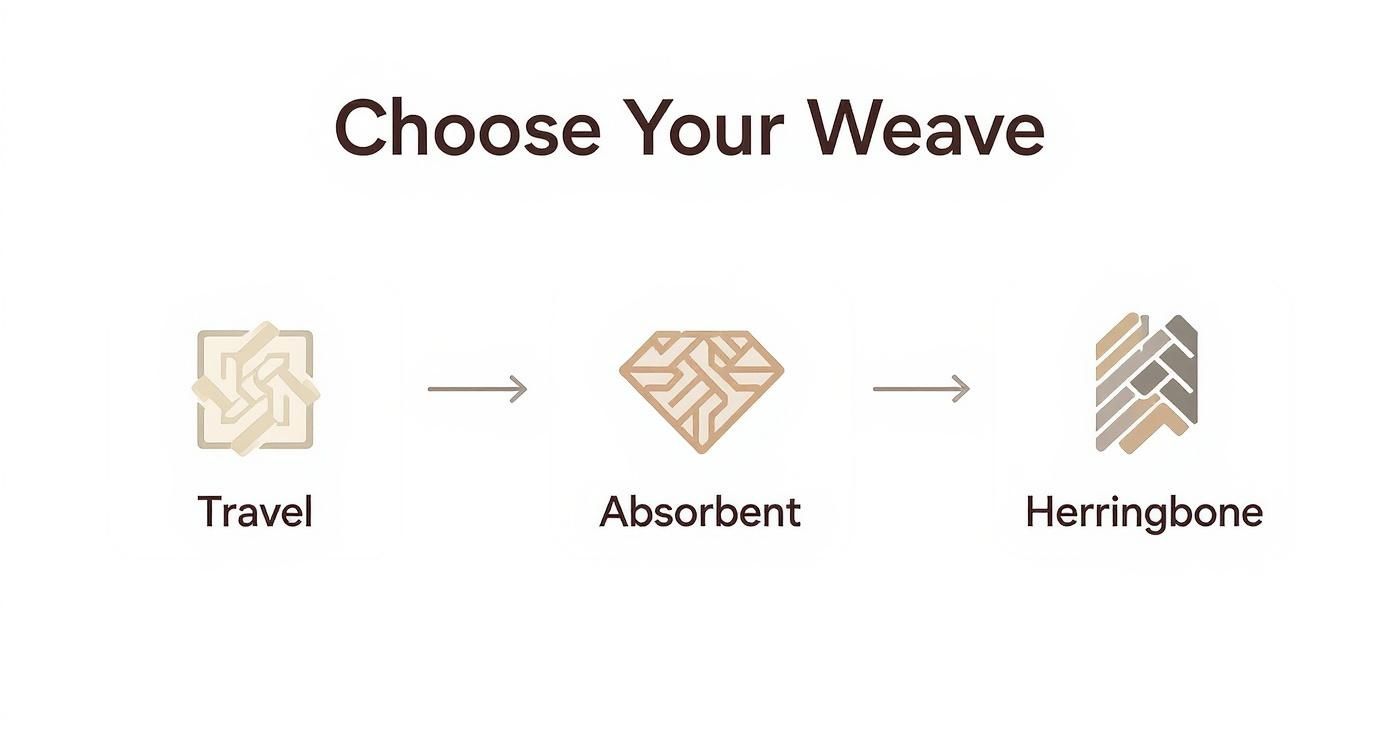
As you can see, a lightweight flat weave is a traveler’s best friend, a diamond weave is great for extra absorbency, and a herringbone weave delivers that wonderfully plush, luxurious feel.
Finding Your Perfect GSM
Low GSM (around 200-300): These are the ultralight champions. A towel in this range is incredibly lightweight and dries in what feels like minutes. This makes it the go-to for backpackers, gym bags, or anyone who needs to pack light and move fast. It’s more like a light, soft sheet than a thick terry towel.
Mid-Range GSM (around 350-500): This is the sweet spot for most people. Towels in this range offer the best of both worlds—they’re still very absorbent and compact, but they have a bit more substance and a softer hand-feel. It's the perfect all-rounder for everyday beach trips or family outings.
High GSM (over 500): If you’re after that spa-like, indulgent experience, this is your range. These towels are noticeably plusher, cozier, and extra absorbent. They’re fantastic for lounging by the pool or using as a luxurious bath sheet at home. Just remember, that extra plushness means they'll be a bit heavier and take a little longer to dry.
Selecting the Right Dimensions
Turkish towels come in a few common sizes, each suited for different uses.
-
Standard Size (approx. 35 x 70 inches): This is your classic, do-it-all size. It’s large enough to comfortably wrap up in after a swim but still folds down small enough to disappear into your tote bag.
-
Oversized or Bath Sheet (approx. 40 x 80 inches): For those who want a little extra real estate, an oversized towel is perfect for sprawling out on the sand or for taller people who need more coverage. It can even pull double duty as a small picnic blanket.
To make it even clearer, here’s a quick breakdown of how GSM and size come together for different activities.
Your Guide to Turkish Towel GSM and Size
| GSM Range | Typical Size | Best For | Key Characteristics |
|---|---|---|---|
| 200–300 GSM | Standard | Travel, Backpacking, Gym | Ultralight, fastest-drying, most compact |
| 350–500 GSM | Standard or Oversized | Everyday Beach Trips, Family Use | Versatile, absorbent, quick-drying with a soft feel |
| 500+ GSM | Oversized | Poolside Lounging, Home Bath | Plush, highly absorbent, luxurious and cozy |
Ultimately, choosing the right towel is about matching it to the life you live. A solo traveler will value different features than a family heading to the local pool. By thinking about both GSM and size, you can find a Turkish towel that feels like it was made just for you.
Pro Tip: When in doubt, go slightly oversized. That little bit of extra fabric is surprisingly versatile, giving you more to wrap up in, more space to lounge on, or an impromptu sarong in a pinch.
How to Care for Your Towel So It Lasts Forever
https://www.youtube.com/embed/URZSt3PM5Xw
A high-quality Turkish towel is a true investment. With the right care, it doesn't just last—it actually gets better, softer, and more absorbent with age. Taking a few simple steps will protect those beautiful long-staple cotton fibers for years to come.
The most important step happens before you even use it. Give your new towel a good soak in cool water for about 12 hours, then hang it up to dry. This one-time prep allows the cotton fibers to bloom and expand, essentially "waking them up" and priming them for maximum absorbency right from the start.
Washing and Drying Best Practices
When it comes to washing, think gentle. A cool or warm cycle with a mild, eco-friendly detergent is all you need. To avoid unnecessary friction, wash your towel with similar colors and don't overcrowd the machine.
Here are a few golden rules to keep in mind:
- Skip the Fabric Softener: Fabric softeners and dryer sheets are the enemy of absorbency. They coat the cotton fibers in a thin, waxy film that repels water, which is the last thing you want for a towel.
- Avoid Bleach: Bleach is far too harsh for natural cotton. It can weaken the fibers, making them brittle and causing them to break down long before their time.
- Air-Dry Whenever Possible: Hanging your towel to dry is the absolute best way to preserve it. This protects the fibers and helps keep the hand-tied tassels from coming undone. If you must use a dryer, stick to a low-heat, gentle setting.
Sticking to these tips will ensure your towel stays in beautiful condition. For an even more detailed breakdown, be sure to read our complete guide on how to care for your Turkish towel.
Even the best towels can sometimes develop a stubborn odor. Learning how to properly remove musty smell from towels is a great skill for keeping all your linens smelling fresh and clean.
Creative Ways to Use Your Peshtemal Every Day
If you only pack your peshtemal for sunny beach days, you're missing out on its real magic. Think of it this way: once you own one, you'll start to realize that the best Turkish beach towel is secretly one of the most versatile items you can have. Its lightweight feel, quick-drying fabric, and gorgeous designs make it the perfect sidekick for all sorts of situations.
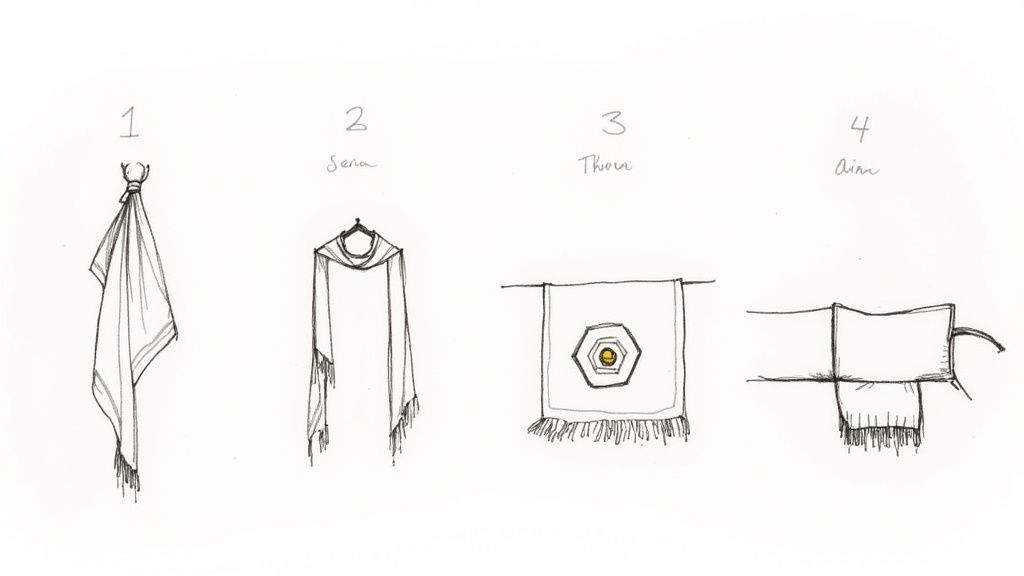
This incredible adaptability is what makes it so much more than just a vacation purchase. It effortlessly goes from a practical tool to a multi-purpose accessory, bringing a bit of style and convenience into your everyday life.
Beyond the Beach: A Style Statement
The most obvious transformation is from towel to fashion statement. With a simple knot or two, your peshtemal becomes a chic sarong or an elegant pareo, perfect for grabbing lunch by the pool.
But don't stop there. On a cooler evening, its soft fabric and generous size make it a fantastic wrap or scarf. Just drape it over your shoulders for a pop of color and a touch of warmth, all without the bulk of a real jacket.
Around the House and On the Go
The usefulness of a peshtemal doesn't end when you get home. In fact, its stylish patterns and textures make it a beautiful accent piece for your living space.
- A Lightweight Throw: Casually toss it over an armchair or across the foot of your bed. It's an instant way to add a layer of texture and color to your decor.
- An Impromptu Tablecloth: Spontaneous picnic in the park? Rustic dinner party? A peshtemal elevates your table setting in seconds.
- A Travel Companion: It's the perfect travel blanket for a chilly plane or car ride. It keeps you comfortable and takes up almost no space in your bag.
- A Yoga Mat Cover: Its absorbent nature and solid grip make it an excellent cover for a yoga mat, especially during a hot yoga session.
The true beauty of a Turkish towel lies in its effortless ability to adapt. It encourages a minimalist mindset by proving that one high-quality, thoughtfully designed item can serve dozens of purposes.
These ideas are really just the beginning. For even more inspiration, check out these 14 ways to use a Turkish towel that can simplify and beautify your daily routine.
Got Questions About Turkish Beach Towels? We've Got Answers.
Even with all their amazing qualities, it's smart to ask a few questions before picking out your perfect Turkish towel. Let's clear up some of the most common things people wonder about so you can feel great about your choice.
A big one we hear is: "Are they really as absorbent as my thick, fluffy towels?" The answer is a definite yes, and it all comes down to the cotton. The magic is in the long, premium fibers of Turkish cotton, which are incredibly thirsty by nature.
They might feel thinner, but the flat weave is hyper-efficient. It wicks water right off your skin. Think of it like high-tech athletic wear versus a bulky cotton sweatshirt—one is designed for performance and dries in a flash, and that's exactly what a Turkish towel does.
Do They Actually Get Softer With Use?
They sure do, and it's one of the best things about them. Most towels get stiff and scratchy over time, but Turkish towels do the complete opposite. With every wash, those long cotton fibers relax and open up, making the fabric feel even softer and more luxurious.
It’s one of those rare things in life that genuinely improves with age. You're not just buying a towel; you're investing in something that will feel better and better every time you use it.
Are Turkish Towels a Good Choice for Sensitive Skin?
Yes, they're fantastic for sensitive skin. Real Turkish towels are made from 100% natural Turkish cotton, a material that is naturally hypoallergenic. Many, like the ones we offer, are also OEKO-TEX certified, which is your guarantee that they’re free from nasty chemicals or synthetic dyes.
The gentle, flat weave glides over your skin with much less friction than the chunky, looped texture of a standard terrycloth towel. This makes them a wonderfully soothing option for everyone, from adults to babies.
How Do I Stop the Tassels from Coming Undone?
Those hand-tied tassels are part of the charm, and keeping them looking great is easy. The main trick is to be gentle when you wash your towel. Don't cram the washing machine too full, which can cause them to get tangled up and pulled.
If a knot happens to come loose, it's no big deal. You can fix it in seconds. Just split the threads into two bunches, twist each one tightly, then tie them together with a firm double knot. A little bit of care now and then will keep your towel looking beautiful for years to come.
Ready to feel the difference for yourself? Dive into the artisan-crafted collection at Anatolico and find the perfect towel to upgrade your beach trips and your home. You can find our authentic, OEKO-TEX certified Turkish towels at https://www.anatolico.co.

